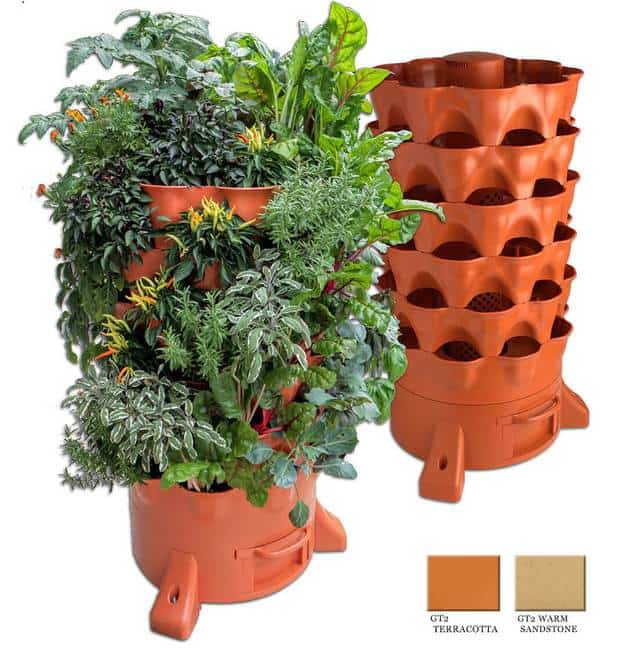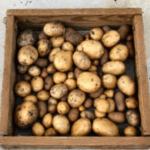These 5 space-saving vegetable garden ideas offer urban gardeners, apartment gardeners, and anyone with limited space the ability to grow lots of plants in small spaces.
I’ve put together the following 5 ideas to help you grow your dream kitchen garden – vegetables, herbs, fruits, and edible flowers – even on a tiny city balcony.
Responsival sponsored this post.
5 Easy Space-Saving Vegetable Garden Ideas
“Why is she writing about space saving vegetable garden ideas? She has acres and acres of beautiful Virginia farmland!”
It’s true that I have a huge area to play with now, but it wasn’t always like that. I grew up in a small urban town called Floral Park. It’s on the edge of Queens, New York, and each house sits on a lot roughly 60 x 90 feet wide. That’s it.
Our house was on a very small lot and we didn’t have much room in the backyard. My dad managed to install a walk-in greenhouse against the garage, a compost pile in the back corner of the yard, and several raised garden beds. He grew prize-winning chrysanthemums plus tomatoes, lettuce, cucumbers, green beans, peppers, and more, all within that tiny space.
Many years later, as a young bride, I moved into an 800 square foot apartment on the second floor of my in-law’s home. The only space for me to garden was on their sunny patio. I set out huge pots and containers and grew tomatoes, peppers, eggplant, cucumbers, and even cantaloupe!
A garden is never finished. Gardeners are always looking for new ideas. Even if space is limited, you can expand the garden in new and beautiful ways.
Space-Saving Vegetable Garden Ideas: Vertical Gardens
Think UP when it comes to vegetable gardens to save space. Vertical gardens utilize the space above the plant to grow more in less space.
1. Ladder Gardens (Vertical Planters)
Ladder gardens, or vertical planters, take the idea of space-saving concepts seriously. Using a stepped shelving system or an actual ladder, these gardens can be freestanding or leaning against a garage, building, or fence.
Actual ladders can be repurposed as garden shelving. Set up the ladder in the area where you’d like to grow your herbs, vegetables, or small fruit (strawberries are ideal in these kinds of gardens). Make sure the containers you plan to use or large enough for the intended plants and have holes in the bottom of the container to allow for excess water to drain off.
Drill holes in the rungs of the ladder and affix containers with screws. Then, fill generously with potting soil, compost, and plants. Water deeply and fill your ladder with your dream kitchen garden. Good plants for the lower rungs of the ladder are patio tomatoes or cherry tomatoes, with herbs and edible flowers such as nasturtiums on higher rungs as well as strawberry plants. Strawberries love to drape over the sides of their containers and look so pretty on higher ladder rungs!
2. The Garden Tower
For space-saving vertical gardening, The Garden Tower is a terrific invention. The Garden Towersaves plenty of space while enabling gardeners to grow up to 50 plants in one square foot. But here’s the secret of why so many organic kitchen gardeners love The Garden Tower: it includes a built-in composter, too.
How does it work? The Garden Tower features a rotating cylinder with what gardeners call ‘plant pockets’ or ‘strawberry pot’ pockets set at an angle in tower. These are similar to strawberry jars, which have soil in the center and angled pockets for the plants. This system makes it easy to grow many plants in a small area.
The Garden Tower is a little ecosystem all its own. Inside the center is a tube that containers a chute at the top where you add kitchen scraps. Worms added to the garden tower eat the scraps and nourish the soil with their poop. I’ve written about vermiculture, or worm composting, in my interview with Henry Owen. It’s a great idea for gardeners in small spaces and adds nourishment with very little work (except by the worms, but hey, we all have to eat!)

Self Composting Ecosystem
In a few weeks after assembling and planting your Garden Tower, the plants’ roots reach into the central composting chute. By then the bacteria and worms have done their work and broken down your kitchen scraps into nourishment.
Another great aspect of this product: the tower itself rotates. It’s set on ball bearings so you can turn it to access all of your plants as well as water each plant or turn them towards the sun, if necessary.
Appropriate for Herbs, Lettuce, Strawberries
The Garden Tower is appropriate for growing herbs, strawberries, lettuce and leafy greens. If you live in an urban environment this is a wonderful product.
It retails for $499 but The Garden Tower Project site often has sales, and if you sign up for their mailing list, coupons are available. The company behind the product also offers payment plans.
3. Jar Gardens (or Windowsill Herb Gardens)
Jar gardens are great to add herbs to your windowsill. The only drawback is that you cannot add drainage holes in the bottom of the container. Recycled glass or plastic food-grade jars work great for a windowsill jar garden.
I’ve taken spaghetti sauce jars, washed them in warm, soapy water, scraped off the labels and voila – instant jar garden! A small stripe of chalkboard paint (available at art and craft stores) lets you write the name of the plant on the jar with a bit of chalk.
Easy herbs to grow in a windowsill jar garden include parsley, basil, thyme, rosemary, and oregano. You can also use jar gardens to root cuttings, too.
4. Window Box Gardens
Window boxes seem to have gone out of favor these days, and that’s a shame. I love the old-fashioned charm of window boxes. And who said that window boxes are just for flowers?
True, they are shallow, and can only hold a few plants, but if you have a sunny window and the ability to add an old-fashioned window box, they are perfect for growing strawberries, leafy green vegetables, and herb plants.
When I gardened in my childhood home in Floral Park, the yard was so small that we used every square inch of the raised beds in the backyard for bigger plants like cucumbers, peppers and tomatoes. I grew herbs in a kitchen window box. Not only was it a great space saving garden idea, it made the window pretty from the outside and fragrant, inside, when the morning sunlight warmed the herbs. And, because the herbs were growing right outside of the kitchen, it was easy to snip a few here and there to add to meals while they cooked.
5. Trellises and Arbors
Trellises and arbors offer another method to grow more vegetables in less space. Construct them from poles sunk into the ground and garden twine stretched between the poles. I used the flexible, easy store tomato cages as garden towers and trellises last year. I set up three in one of the raised beds and grew cucumbers around them. The cucumbers had a place to cling to and the vertical trellises enabled me to grow an abundance of vegetables in a very small space in the garden.
Some gardeners stretch wire over the walkways in their garden and allow all sorts of vines to grow up and over the pathways. I’ve seen gourds, squash, and cucumbers grown this way. All types of runner and pole beans can be grown vertically on trellises, too.

Varieties for Space Saving Vegetable Gardens
I hope that these five space-saving ideas are helpful to you if you struggle with gardening in small spaces. Here are a few tips for a kitchen garden in a small space:
- Choose container vegetable and fruit varieties. For example, patio varieties of tomatoes stay small and provide plenty of fresh tomatoes for salads. “Minnesota Midget,” a variety of cantaloupe, needs a vertical support but can be grown in small spaces unlike its traditional melon cousins. Bush varieties of cucumbers take up much less space than vining ones. Look for varieties marked “bush” and “patio” or “container” for plants that take up less room.
- Decide what you’d like to grow based on freshness, taste, and ability to grow it successfully.
- Pick the container or space-saving gardening methods based on what the plants need and the space you have available. You can grow potatoes in a deep container (like a trash can) in a small space but jars are better used for small herbs that do not require much soil for their roots.
- Always place your garden with consideration first, for the light, and second, for access to water. All vegetables, fruits and herbs thrive in bright, direct sunlight, so look for the sunniest spot you have for your garden. And access to water is critical, so make sure you new garden isn’t placed so far from a hose (or the house) that it’s hard to carry water to it.
I hope that these ideas for small gardens are helpful to all of our urban homesteaders out there. Kitchen gardens can be grown in small spaces. You just need a little ingenuity, the right plants, and ideas like these to get started.
I was absolutely delighted when Responsival contacted me and asked to sponsor this blog post. While Responsival did indeed sponsor this post, all of the opinions and thoughts shared here are my own.




